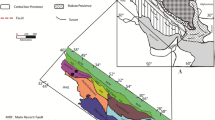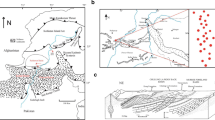Abstract
The origin and depositional setting of dolomites remain a complex and debated topic. In the Indus Basin Pakistan, the dolomites in Jutana Formation form a thick sequence within the Cambrian stratigraphy. The current study investigates the detailed depositional setting as well as the mineralogical composition of dolomites in the Jutana Formation to provide insight into their origin. The study focuses on integrating the microfacies and Scanning Electron Microscopy (SEM) with X-ray diffraction (XRD) data along with Wireline logs of Jutana Formation in Khewra Gorge, Eastern Salt Range. Based on field and petrographic observations, four microfacies were identified including (a) siliciclastic algal laminated dolomitic breccia (MJD-1), (b) burrowed sandy ferroan dolomicrite (MJD-2), (c) in-situ medium-coarse grained dolomicrite-dolosparite (MJD-3), (d) fine grained micaceous dolosparite (MJD-4). The microfacies analysis reveals that the deposition of the Jutana Formation is primary on carbonate platform in peritidal environments, ranging from supratidal to subtidal. Digenesis has obliterated most of the primary depositional features, making the interpretation of the original depositional setting challenging. The XRD analysis suggests that these dolomites are nearly stoichiometric and less ordered, indicating an early diagenetic setting, further supported by the presence of anhydrite seen under the SEM. The original depositional setting on the carbonate platform is also supported by cross plot graph wireline logs.











Similar content being viewed by others
Data availability
No datasets were generated or analysed during the current study.
Change history
12 April 2024
A Correction to this paper has been published: https://doi.org/10.1007/s13146-024-00960-7
References
Ahmad N, Ahsan N, Sameeni SJ et al (2013) Sedimentology of the early Middle Cambrian Jutana formation of Khewra area, Eastern Salt Range, District Chakwal, Pakistan. Sci Int 25
Baccelle L, Bosellini A (1965) Diagrammi per la stima visiva della composizione percentuale nelle roccē sedimentarie. Università degli studi di Ferrara
Desheng Y (1987) Bird’s-eye structures in carbonate rocks and their environmental significance. AAPG (Am Assoc Pet Geol) bull;(United States) 71
Friedman GM, Sanders JE (1967) Origin and occurrence of dolostones. Developments in sedimentology. Elsevier, pp 267–348
Gee ER (1945) The age of the Saline Series of the Punjab and of Kohat. Proceedings of the National Academy of Science India 14:269–310
Given RK, Wilkinson BH (1987) Dolomite abundance and stratigraphic age; constraints on rates and mechanisms of phanerozoic dolostone formation. J Sediment Res 57:1068–1078
Goldsmith JR, Heard HC (1961) Subsolidus phase relations in the system CaCO3-MgCO3. J Geol 69:45–74
Gregg JM, Bish DL, Kaczmarek SE, Machel HG (2015) Mineralogy, nucleation and growth of dolomite in the laboratory and sedimentary environment: a review. Sedimentology 62:1749–1769
Haq BU, Boersma A (1998) Introduction to marine micropaleontology. Elsevier
Hardie LA (1987) Dolomitization; a critical view of some current views. J Sediment Res 57:166–183
Kadri IB (1995) Petroleum geology of Pakistan. Pakistan Petroleum Limited
Kazmi AH, Jan MQ (1997) Geology and tectonics of Pakistan. (No Title)
Kazmi A, Rana R (1982) Tectonic map of Pakistan. Scale 1:2000000, first edition
Khan S, Shah MM (2019) Multiphase dolomitization in the Jutana formation (Cambrian), Salt Range (Pakistan): evidences from field observations, microscopic studies and isotopic analysis. Geologica Acta 17:1–18
Khan MA, Khan MJ, Alizai SAK (1977) Stratigraphy and petrography of the Jutana Dolomite, Khewra Gorge Khewra, Jehlum District; Punjab: Pakistan. Geol Bull Univ Peshawar 9:43–66
Land LS (1985) The origin of massive dolomite. J Geol Educ 33:112–125
Lippmann F, Lippmann F (1973) Crystal chemistry of sedimentary carbonate minerals. Springer
Loucks RG, Longman MW (1982) Lower cretaceous Ferry Lake Anhydrite. product of shallow-subtidal deposition, Fairway field, east Texas
Lumsden DN, Chimahusky JS (1980) Relationship between dolomite nonstoichiometry and carbonate facies parameters
Miall AD (2004) Empiricism and model building in stratigraphy: the historical roots of present-day practices. Stratigraphy 1:3–25
Morrow DW (1982) Diagenesis 1. Dolomite-Part 1: the chemistry of dolomitization and dolomite precipitation. Geosci Can 9:5–13
Pickett GR (1977) Recognition of Environments and Carbonate Rock Type Identification in Formation Evaluation Manual Unit II, section exploration wells: Oil and Gas Consultants International Inc. International, Inc 4–25
Pina CM, Pimentel C, Crespo Á (2020) Dolomite cation order in the geological record. Chem Geol 547:119667
Qiu X, Wang H, Yao Y, Duan Y (2017) High salinity facilitates dolomite precipitation mediated by Haloferax volcanii DS52. Earth Planet Sci Lett 472:197–205
Rahman MU, Ali F, Hayat M (2016) Diagenetic setting, Dolomitization and Reservoir characterization of late cretaceous Kawagarh formation, Khanpur Dam section, Hazara, Pakistan. Int J Economic Environ Geol 7:64–79
Rahman MU, Ali F, Faisal S et al (2017) The impact of Diagenesis and Dolomitization on the Reservoir Potential of Middle Jurassic Samana Suk formation from Khanpur Dam Section Hazara Basin, Khyber Pakhtunkhwa Pakistan. Int J Econ Environ Geol Vol 8:40–54
Schindewolf OH, Seilacher D (1955) in der Salt Range (Pakistan). Abhandlungen der Mathematisch-Naturwissenschaftlichen Klasse 255
Scholle PA, Ulmer-Scholle DS (2003) A color guide to the petrography of carbonate rocks: grains, textures, porosity, diagenesis, AAPG Memoir 77. AAPG
Selley RC, Cocks LRM, Plimer IR (2005) Encyclopedia of geology. Elsevier Academic
Shah SMI (1977) Stratigraphy of Pakistan
Shah MM, Ahmed W, Ahsan N, Lisa M (2016) Fault-controlled, bedding-parallel dolomite in the middle jurassic samana suk formation in Margalla Hill Ranges, Khanpur area (North Pakistan): petrography, geochemistry, and petrophysical characteristics. Arab J Geosci 9:1–18
Shinn EA (1983) Tidal flat environment. Carbonate depositional environments. American Association of Petroleum Geologists Tulsa, OK, pp 171–210
Sibley DF, Gregg JM (1987) Classification of dolomite rock textures. J Sediment Res 57:967–975
Tucker ME (2003) Sedimentary Rocks in the Field THIRD EDITION
Vasconcelos C, McKenzie JA, Bernasconi S et al (1995) Microbial mediation as a possible mechanism for natural dolomite formation at low temperatures. Nature 377:220–222
Warren J (2000) Dolomite: occurrence, evolution and economically important associations. Earth Sci Rev 52:1–81
Wright VP, Tucker ME (1990) Carbonate sedimentology. Blackwell scientific publications
Wu X (1982) Storm-generated depositional types and associated trace fossils in Lower Carboniferous shallow-marine carbonates of three cliffs Bay and Ogmore-by-Sea, South Wales. Palaeogeogr Palaeoclimatol Palaeoecol 39:187–202
Acknowledgements
The authors are thankful to University of Peshawar for assistance during field work. The authors are also show deep gratitude to the Institute for Advanced Marine Research, CUG Guangzhou for interpretation and laboratory analysis.
Author information
Authors and Affiliations
Contributions
M.I, H.R, S.S.H proposed the research work and performed the fieldwork, M.R, and A.K helped the field party in the analysis and interpretations. M.I, H.R, S.S.H prepared the initial draft of the manuscript which is finalized by M.R. All the research work was under the supervision of S.K.
Corresponding author
Ethics declarations
Competing interests
The authors declare no competing interests.
Conflict of interest
There is no financial or ethical conflict of interest among the authors or with any third party.
Additional information
Publisher’s Note
Springer Nature remains neutral with regard to jurisdictional claims in published maps and institutional affiliations.
The original online version of this article was revised due to correction in affiliation.
Rights and permissions
Springer Nature or its licensor (e.g. a society or other partner) holds exclusive rights to this article under a publishing agreement with the author(s) or other rightsholder(s); author self-archiving of the accepted manuscript version of this article is solely governed by the terms of such publishing agreement and applicable law.
About this article
Cite this article
Ibrar, M., Rehman, H.U., Khan, S. et al. A detailed investigation of Jutana Formation for depositional setting in Indus Basin, Pakistan. Carbonates Evaporites 39, 24 (2024). https://doi.org/10.1007/s13146-024-00951-8
Accepted:
Published:
DOI: https://doi.org/10.1007/s13146-024-00951-8




